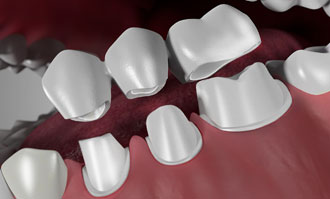How dental bridges can reduce the risk of gum disease?
The quote rightly says “YOU ARE NOT AT EASE IF YOU HAVE A GUM DISEASE”. This is true to the most extent. Gum disease can have a devastating effect on one’s life and can lead to serious dental complications until early treatment is availed and symptoms are detected.
Gum-related disease affects millions of Americans. Are you one of them? As per a recent study undertaken, there are currently over six hundred species of bacteria known to exist in the mouth alone, with only about four hundred currently identified.
Gum disease also known as “Periodontal disease” is derived from the latin word “Perio” means around and “Odont” meaning tooth. There are various factors that trigger gum disease. Dental plaque is one of the main culprits behind leading to gum disease. Factors like poor nutrition, diet, lack of quality oral hygiene lead to gum diseases. people who are heavy smokers are more prone to rapid bone loss and have a greater risk of gum disease.
Gum disease results in inflammation of the gums (gingivitis), destruction of the ligament, loss of bone and tooth loss.
Signs and symptoms of gum disease:
The initial signs of gum disease begin with gingivitis where the gums appear swollen at the margins. They also bleed while brushing or flossing. Beside bad breadth and taste are also associated with gum diseases. As the disease begins to intensify gum tissues begin to recede, exposing the surfaces of the root which will cause tooth sensitivity to temperature. If not treated on time, it can lead to abscess formation denoted by severe pain, swelling and discharge from the gum tissue.
Treating gum disease- What to Expect
Gum disease can occur in children, teens and adults. Early gum disease can be detected by your dentist during regular dental checkups. Depending on the severity and findings, your dentist may refer you to a “Periodontist” who is a specialist in diagnosing and treating gum disease. A periodontist will examine your gums and take appropriate steps to encounter the disease. Since plaque and tartar are the root cause of gum disease, removing the same will be the highest priority of periodontist. Gum disease can be treated surgically and non-surgically. Sometimes non-surgical therapies do not respond to severe cases. In such situations, your periodontist will opt for surgical treatment.
Can dental bridges reduce the risk of gum disease?
Yes!!! Dental bridges can help reduce the risk of gum disease to a great extent. Though bridges have been used extensively to replace missing tooth over the years, they can also reduce the risk of bacteria causing gum disease.
When you have a missing tooth the teeth on either side tend to drift into space. This leads to lodgment of food particles, gum problems and occlusion problems. When the teeth are lost, it invites the formation of bacteria over the empty space and triggers serious gum problems. The teeth that are drifted take an excess load as it hampers the biting force. This may lead to advanced gum disease. Therefore in order to reduce such gum disease, dental bridges are the best options.
Materials used in dental bridges:
Dental bridges come with metal, ceramic, porcelain and combination of all. Metal bridges can be of cobalt and Chromium. They also consist of palladium, silver and gold.
Kinds of dental bridges:
Dental bridges can be broadly classified into three types namely;
Traditional bridges – Traditional bridges are the most common form of dental bridges used over the years to replace missing tooth.
Cantilever bridges – Such bridges are applicable when there are teeth on only one side of the lost teeth.
Maryland bridges – Such bridges are made of porcelain or porcelain fused to metal. Maryland bridges have metal or porcelain wings on either side that is bonded to the existing teeth.
If you have any queries, feel free to consult your dentist and find out how dental bridges can reduce the risk of gum disease.

